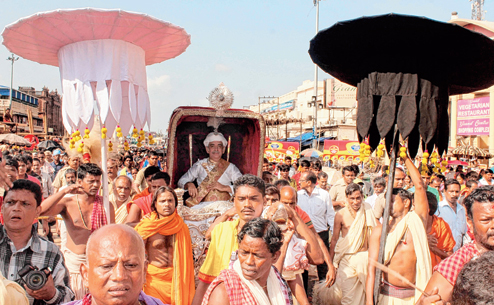
The king of Puri goes on a royal ride from his palace to the Lord's chariots every year in a palanquin carried by 15 sturdy men. These men speak with pride of being chosen to perform this ritual, which is a throwback to medieval times.
The tamzan or palanquin, which carries Puri king Gajapati Dibya Singh Deb to the chariots to perform the ceremonial chhera panhara (sweeping of the chariots), is an unmistakable sight during rath yatra and bahuda, the return journey of the deities.
The royal palanquin gets its name tamzan from the times when Puri used to be under Mughal rule, a historian said.
The tradition of the king riding a medieval carriage borne by 15 men is a reminder of the chariot festival's feudal past that lingers on. However, the men carrying the king are proud of that fact that they have a lifetime of opportunity to serve the Lord by carrying the king to the chariots.

Chief of the group Sadasib Behera said: "It's almost as if I am transported to another world while taking the lead in carrying the tamzan. When we are carrying the king, we feel as if we are we are carrying the living deity and not a human being."
The 15 men who carry the palanquin are required to follow a strict vegetarian diet and remain celibate during the car festival.
"Every year, there are three occasions on which we get to carry the tamzan. One, during Snana Purnima when the Lord comes out of the temple to take a bath with 108 pitchers of holy water, another during the day of rath yatra and the third on bahuda yatra, the return of the divine siblings to the 12th century shrine. On all these occasions, the king has to sweep the platform of the three chariots with a golden broom."
Behera, who belongs to the fishermen caste, said that although he had been performing this service for 30 years without a single day of absence, he never tires of it.
"On all these three occasions, we don't have anything to eat until the king completes his holy duty and returns to the palace. After that, we are served the mahaprasad."
He recalled how the procession of carrying the king used to be a bigger and grander affair.
"Earlier, an elephant decorated in finery used to lead the procession and guide the king to the chariots and temples. That was a spectacular scene that appeared very royal and grand. With the passage of time, that practice has been abolished," he said.
The temple administration probably decided to stop the practice because there was a possibility of the elephant going on the rampage due to nervousness from being am ong the milling crowds, he said.
He spoke of the days when devotees would offer their pranam to them as they carried the king to the chariots.
"Now, it's more about curiosity than devotion. The palanquin that we carry is special, it's no ordinary one."
"The palanquin is made of ivory and silver plate. It is also very heavy. Earlier, 12 of us used to carry it. Since the last few years, I have added three more men to the group. You need to be of a sturdy build to be able to carry the heavy tamzan."
On the rath yatra and Snana Purnima days, the king travels in the palanquin from the palace to the chariots covering a distance of 300 metre. On bahuda yatra, king covers the distance from his palace to Badasankha on the Grand Road by car. From there, he gets into the tamzan and covers 300 metre to the chariots in front of Gundicha Temple.
Behera said he was confident that his two sons would carry forward the tradition.
"We never feel any humiliation while carrying the tamzan, on the contrary, we feel honoured to do it. I have already roped in my nephew to do this job. I am hopeful that my two sons will also join me in future."

Behera's nephew Alok, a 20-year-old engineering student from a college of repute in Bhubaneswar, said: "When my uncle asked me last year to join him, my joy knew no bounds. I immediately agreed. It in no way affects my studies. Regular studies will help you get a job. But practising religion with a broad mind enlightens you. I am fortunate to be a part of this tradition."
The Bengal government had tried to stop hand-pulled rickshaws from plying in the streets of Calcutta. Asked why that practice should not be followed here, Alok said: "In their case, people are forced to pull the rickshaws to earn their livelihood. Here, we do it out of devotion, not for money."
The palace has given Rs 15,000 as honorarium to the group to carry out the service. "The team leader later distributes the money among all the members,"he said.

